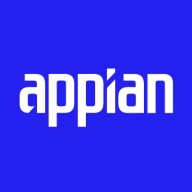

Appian and Apache Airflow both compete in the realm of application development and data orchestration, with Appian focusing on business processes and Airflow on data workflows. Appian seems to have an advantage in rapid application deployment due to its low-code capabilities, while Apache Airflow stands out for its flexibility and community support in complex data workflow creation.
Features: Appian offers low-code rapid development, advanced BPM integration, and strong case management features, facilitating quick deployment and faster ROI. Apache Airflow provides Python-based flexibility, a robust directed acyclic graph (DAG) architecture, and extensive integration options, making it ideal for complex data workflows and automation in a Python environment.
Room for Improvement: Appian could improve its UI customization, offline capabilities, and scalability. Apache Airflow faces challenges with DAG limitations, workflow complexities, and requires manual scaling efforts, impacting its ease of use in larger implementations.
Ease of Deployment and Customer Service: Appian supports diverse deployment options including public and hybrid clouds and is praised for customer service, though technical support varies. Apache Airflow, being open-source, lacks structured support but benefits from a robust community, offering flexible deployment options and strong community-driven problem-solving.
Pricing and ROI: Appian's pricing is on the higher end due to its proprietary nature, but it offers substantial ROI through efficient business process automation. Apache Airflow, as an open-source tool, has low initial costs, appealing to enterprises focusing on data orchestration, with additional commercial support available at extra cost.
Appian is very efficient, allowing us to build a lot of applications within a financial year, making it cost-effective.
There is enough documentation available, and the community support is good.
Forums and community resources like Stack Overflow are helpful.
Their customer service is responsive, and the team is very prompt for support.
The technical support is generally good.
Appian has a community where I can put my questions.
The solution is very scalable.
Apache Airflow scales well, especially when deployed in Kubernetes environments.
Appian is scalable, but it depends on how you build your applications.
Initially, without much coding, I can easily handle five thousand records.
Apache Airflow is stable and I have not experienced significant issues.
I would rate the stability of the solution as ten out of ten.
It depends on how it has been designed and how it has been configured.
It is not suitable for real-time ETL tasks.
There is no dashboard for us to check all the Directed Acyclic Graphs (DAGs); a dashboard would help us analyze the work better.
I would like to see more enhancement in the user interface to allow more freedom in designing the sites and pages.
If there is a very complex process that includes a lot of data transitioning and memory-centric processes, it consumes a lot of memory.
I prefer using the open-source version rather than the enterprise version, which helps manage costs.
Apache Airflow is a community-based platform and is not a licensed product.
On the pricier side, both Appian and Pega are enterprise-level solutions, placing them on the slightly higher side.
The pricing of Appian is based on the number of users and generally ranges from 70 to 100 USD per user per month.
Reliability is good, and when integrated with Kubernetes, it performs better compared to on-premises environments.
Apache Airflow is an open-source platform that allows easy integration with AWS, Azure, and Google Cloud Platform.
The zero-code integration feature is remarkable, allowing for ease of data transfer and workflow enhancement.
I can create tables, perform database-related activities, and create multiple tables.
It is easy for me to define the process and create configurable workflows.


Apache Airflow is an open-source workflow management system (WMS) that is primarily used to programmatically author, orchestrate, schedule, and monitor data pipelines as well as workflows. The solution makes it possible for you to manage your data pipelines by authoring workflows as directed acyclic graphs (DAGs) of tasks. By using Apache Airflow, you can orchestrate data pipelines over object stores and data warehouses, run workflows that are not data-related, and can also create and manage scripted data pipelines as code (Python).
Apache Airflow Features
Apache Airflow has many valuable key features. Some of the most useful ones include:
Apache Airflow Benefits
There are many benefits to implementing Apache Airflow. Some of the biggest advantages the solution offers include:
Reviews from Real Users
Below are some reviews and helpful feedback written by PeerSpot users currently using the Apache Airflow solution.
A Senior Solutions Architect/Software Architect says, “The product integrates well with other pipelines and solutions. The ease of building different processes is very valuable to us. The difference between Kafka and Airflow, is that it's better for dealing with the specific flows that we want to do some transformation. It's very easy to create flows.”
An Assistant Manager at a comms service provider mentions, “The best part of Airflow is its direct support for Python, especially because Python is so important for data science, engineering, and design. This makes the programmatic aspect of our work easy for us, and it means we can automate a lot.”
A Senior Software Engineer at a pharma/biotech company comments that he likes Apache Airflow because it is “Feature rich, open-source, and good for building data pipelines.”
Appian is a unified low-code platform and solution used by businesses to build enterprise applications and workflows. This product adapts to the needs of clients and the technologies they are already using to combine their data in a single workflow and maximize resources. The platform has four main components through which it transforms the work process for companies of various sizes. They are:
Appian is utilized across a diverse set of industries, including automotive and manufacturing, energy and utilities, education, financial services, telecom and media, transportation, retail, insurance, healthcare, and life sciences. The most frequent use cases of Appian are customer journey, governance, risk and compliance, operational efficiency, supply chain, distributed order management, and environmental, social, and governance (ESG) management.
Appian Features
Appian has various features that allow users to create solutions for their businesses. These features can be separated into a few groups according to function, including automation, low-code application development, and integrations and data. Some of the most frequently used features of Appian include:
Appian Benefits
The benefits of using Appian include:
Reviews from Real Users
A practice leader - digital process automation at a computer software company values Appian highly because the product is easy to develop, low-code, and has a good user interface.
Alan G., an advisory board member at Codecon VR, Appian offers a clear application life cycle, easy to learn documentation, and comes with a fundamentals course.
We monitor all Business Process Management (BPM) reviews to prevent fraudulent reviews and keep review quality high. We do not post reviews by company employees or direct competitors. We validate each review for authenticity via cross-reference with LinkedIn, and personal follow-up with the reviewer when necessary.